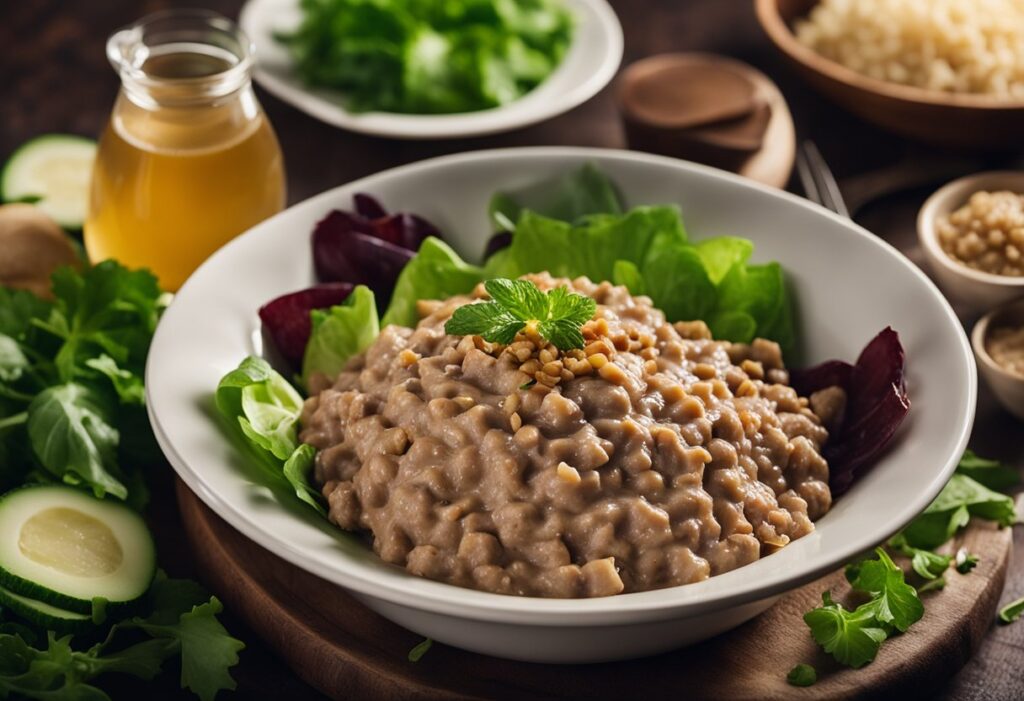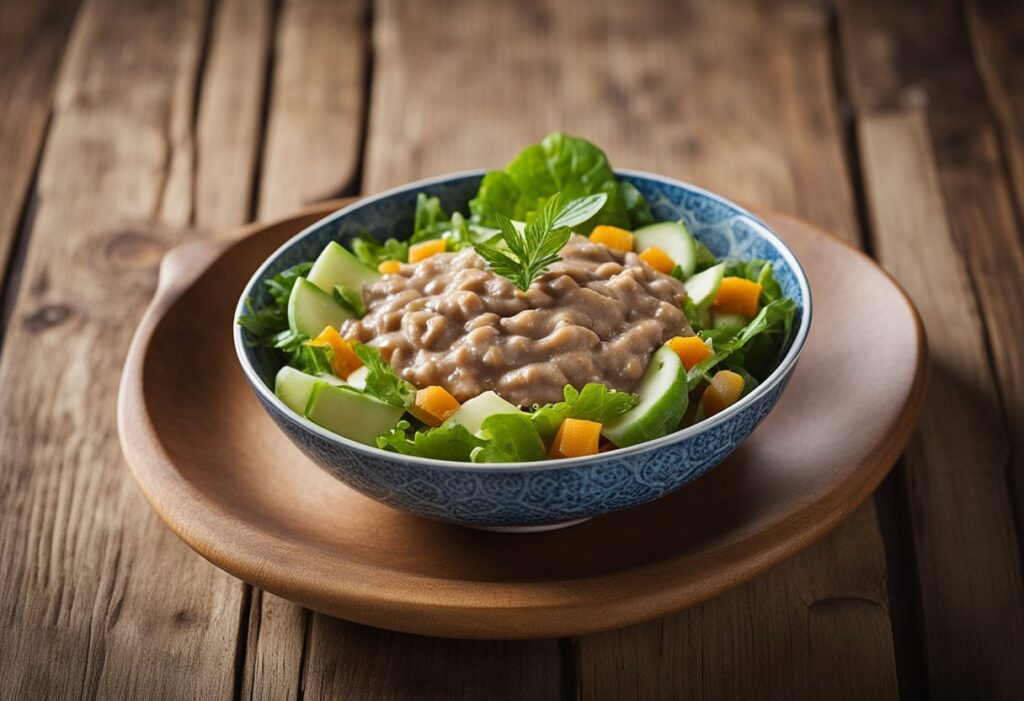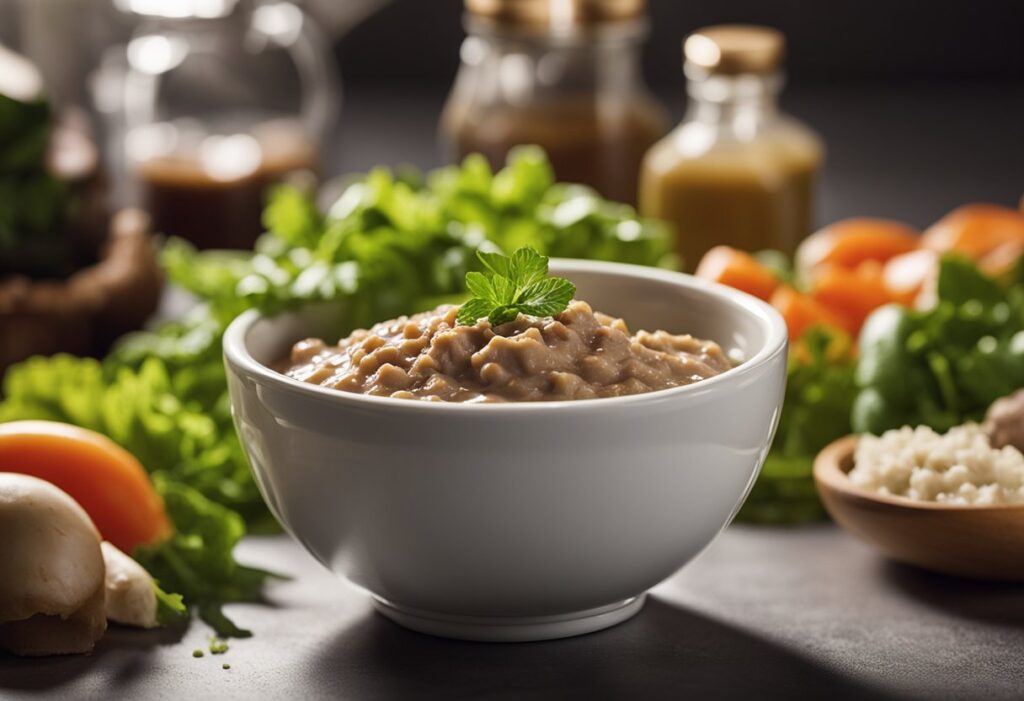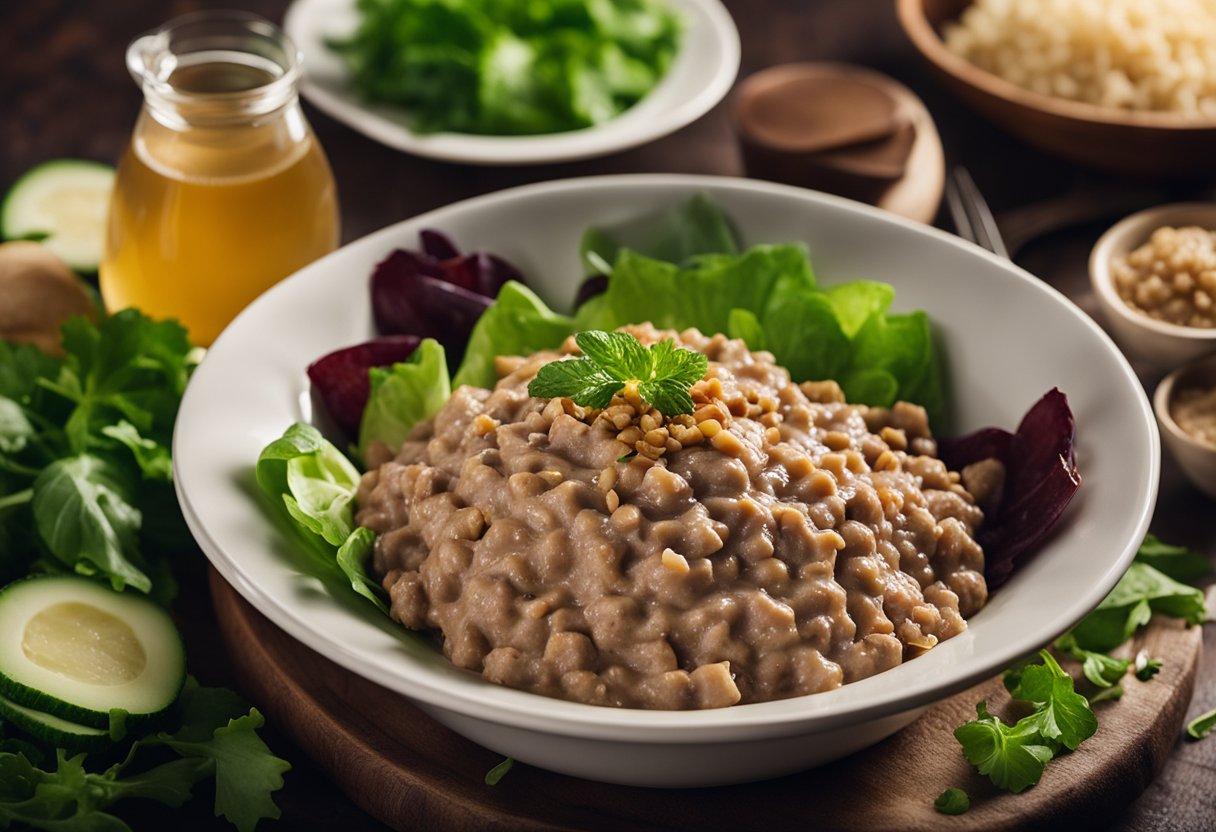Salad dressing can make or break a salad, and it’s often the flavor that brings everything together. There are countless variations of salad dressings, but one that may not be as well-known is salad dressing with chopped liver. This unique dressing adds a rich, savory flavor to any salad and is a popular choice in Jewish cuisine.
Table of Contents

Chopped liver is a traditional Jewish dish made from sautéed chicken livers, onions, and seasonings. It’s often served as an appetizer or spread on bread, but it can also be used as a salad dressing. The chopped liver is blended with oil, vinegar, and other seasonings to create a creamy and flavorful dressing that pairs well with a variety of greens and vegetables.
While salad dressing with chopped liver may not be as common as other dressings, it’s definitely worth trying for those who enjoy bold and savory flavors. It’s also a great way to incorporate a traditional Jewish dish into a modern meal.
Essential Ingredients

Chopped Liver
Chopped liver is the star ingredient in this salad dressing recipe. It adds a rich, savory flavor and a creamy texture to the dressing. The liver should be cooked until it is tender and then finely chopped. For the best results, use fresh chicken liver.
Oil and Vinegar Base
The oil and vinegar base is what gives the dressing its tangy flavor and helps to balance out the richness of the chopped liver. Use a good quality olive oil and red wine vinegar for the best results. The ratio of oil to vinegar can be adjusted to suit personal taste preferences.
Seasonings and Spices
To add depth of flavor to the dressing, a variety of seasonings and spices can be used. Some popular options include garlic, shallots, Dijon mustard, salt, pepper, and fresh herbs such as parsley or chives. These ingredients should be finely chopped or minced before being added to the dressing.
By using these essential ingredients, a flavorful and unique salad dressing can be created that is sure to impress.
Health and Nutrition
Protein Content
Chopped liver salad dressing is a great source of protein. One tablespoon of chopped liver contains approximately 3 grams of protein. Protein is an essential nutrient that helps to build and repair tissues in the body. It also plays a role in the production of enzymes, hormones, and other important molecules.
Fat Content
Chopped liver salad dressing is high in fat, but it is also a good source of healthy fats. One tablespoon of chopped liver contains approximately 4 grams of fat, with about 1 gram of saturated fat. The remaining fats are unsaturated, including monounsaturated and polyunsaturated fats. These healthy fats can help to lower cholesterol levels and reduce the risk of heart disease.
Vitamins and Minerals
Chopped liver salad dressing is a good source of vitamins and minerals. One tablespoon of chopped liver contains important nutrients such as vitamin A, vitamin B12, iron, and zinc. Vitamin A is important for vision and immune function, while vitamin B12 is essential for the production of red blood cells. Iron is important for oxygen transport in the body, and zinc is important for immune function and wound healing.
In summary, chopped liver salad dressing is a nutritious addition to salads. It is a good source of protein, healthy fats, and important vitamins and minerals. However, it should be consumed in moderation due to its high fat content.
Preparation Techniques

Liver Chopping Methods
The key to making a salad dressing with chopped liver is to ensure that the liver is chopped finely and evenly. This can be achieved using a food processor, a meat grinder, or a sharp knife. Using a food processor or a meat grinder will result in a smoother texture, while using a knife will give the liver a coarser texture. It is important to chill the liver before chopping to prevent it from becoming too soft and mushy.
Emulsifying Dressing
To make a creamy and smooth salad dressing with chopped liver, emulsification is necessary. This can be achieved by slowly adding oil to the liver while whisking vigorously. A mixture of oil and vinegar or lemon juice can also be added to the liver to create a tangy and flavorful dressing. It is important to add the oil slowly and whisk continuously to ensure that the dressing emulsifies properly.
Flavor Balancing
When making a salad dressing with chopped liver, it is important to balance the flavors of the liver with the other ingredients. A pinch of salt can be added to enhance the flavor of the liver, while sugar or honey can be added to balance out the bitterness. Acidic ingredients such as vinegar or lemon juice can be added to cut through the richness of the liver. Herbs and spices such as parsley, thyme, or garlic can also be added to enhance the overall flavor of the dressing.
In summary, preparing a salad dressing with chopped liver requires finely and evenly chopped liver, emulsification, and proper flavor balancing. By following these techniques, one can create a delicious and unique dressing that is sure to impress.
Serving Suggestions
Salad Pairings
Salad dressing with chopped liver is a versatile addition to any salad. It pairs well with greens such as arugula, spinach, and mixed baby greens. Additionally, it complements vegetables such as cucumbers, cherry tomatoes, and red onions. For a heartier salad, try adding boiled eggs or croutons.
Portion Sizes
When serving salad dressing with chopped liver, it is important to consider portion sizes. A little goes a long way, so start with a small amount and add more as needed. As a general rule, aim for one to two tablespoons of dressing per serving.
Presentation Tips
To create an aesthetically pleasing salad, consider the presentation of the ingredients. Arrange the greens and vegetables in a bowl or on a plate before adding the dressing. Drizzle the dressing over the salad in a zigzag pattern to evenly distribute the flavor. For a more rustic look, toss the salad with the dressing and serve it family-style in a large bowl.
Overall, salad dressing with chopped liver is a delicious and unique addition to any salad. By following these serving suggestions, you can create a flavorful and visually appealing dish that is sure to impress.
Variations and Alternatives
Vegetarian Alternatives
For those who prefer a vegetarian salad dressing, there are several options available. One popular choice is a vinaigrette made with olive oil, balsamic vinegar, Dijon mustard, and honey. Another option is a creamy avocado dressing made with ripe avocados, lime juice, garlic, and Greek yogurt.
Low-Fat Options
For those looking for a healthier option, there are several low-fat salad dressing alternatives. A simple vinaigrette made with apple cider vinegar, Dijon mustard, and a small amount of olive oil is a great choice. Another option is a yogurt-based dressing made with Greek yogurt, lemon juice, and herbs such as dill or parsley.
Exotic Twists
For those looking to add a unique twist to their salad dressing, there are several exotic options to choose from. A popular Middle Eastern dressing is tahini, made with sesame paste, lemon juice, garlic, and water. Another option is a miso dressing, made with miso paste, rice vinegar, and sesame oil. For a spicy kick, a Thai-inspired dressing made with fish sauce, lime juice, and chili flakes is a great choice.
No matter what your preference, there are plenty of variations and alternatives to traditional salad dressing with chopped liver. Experiment with different ingredients and flavors to find your perfect combination.
Storage and Shelf Life
Refrigeration
Salad dressing with chopped liver should be refrigerated at all times. This helps to prevent the growth of bacteria and other microorganisms that could cause spoilage. It is recommended to store the dressing in an airtight container to prevent contamination.
Expiration Indicators
It is important to check the expiration date on the salad dressing with chopped liver before use. Typically, this type of dressing has a shelf life of around 2-3 weeks when refrigerated. If the dressing has expired, it should be discarded immediately to prevent any potential health risks.
Best Practices for Freshness
To ensure the freshness of the salad dressing with chopped liver, it is recommended to use it within a week of opening. Additionally, it is important to avoid contaminating the dressing by using clean utensils and not double-dipping. If the dressing appears to be discolored or has an off smell, it should be discarded immediately.
Overall, proper storage and handling are crucial to maintaining the quality and safety of salad dressing with chopped liver. By following these guidelines, consumers can enjoy this tasty and unique dressing while minimizing the risk of spoilage and contamination.
Cultural Significance
Historical Background
The use of chopped liver in salad dressing dates back to Jewish cuisine in Eastern Europe during the 19th century. Chopped liver was a staple dish in Jewish households, and its use in salad dressing was a way to add flavor and richness to the dish. Over time, this tradition spread to Jewish communities around the world, where it became a popular ingredient in various salad dressings.
Regional Preferences
The use of chopped liver in salad dressing is most common in Jewish cuisine, but it has also been adopted by other cultures. In the United States, chopped liver salad dressing is a popular dish in Jewish delicatessens and restaurants. In Israel, chopped liver salad dressing is a staple dish in many households, and it is often served with pita bread.
Contemporary Trends
In recent years, chopped liver salad dressing has gained popularity among food enthusiasts and chefs. It is now featured in many modern cookbooks and is often served in upscale restaurants. Some chefs have even experimented with different variations of chopped liver salad dressing, using ingredients such as truffle oil, balsamic vinegar, and honey to add complexity to the dish.
Overall, chopped liver salad dressing has a rich cultural significance, representing the traditions and flavors of Jewish cuisine. Its popularity has spread beyond Jewish communities, becoming a beloved dish around the world.
Food Safety
Raw Liver Risks
Raw liver can pose a risk for bacterial contamination, including Salmonella and E. coli. These bacteria can cause foodborne illness in humans, resulting in symptoms such as nausea, vomiting, diarrhea, and fever. It is recommended to cook liver to an internal temperature of 160°F to reduce the risk of bacterial contamination.
Allergen Information
Chopped liver is typically made with chicken liver, which may pose a risk for individuals with poultry allergies. Additionally, salad dressing may contain common allergens such as soy, egg, and dairy. It is important to read labels carefully and be aware of potential allergens when consuming salad dressing with chopped liver.
Safe Handling Procedures
When handling raw liver, it is important to follow safe handling procedures to prevent cross-contamination. This includes washing hands and surfaces thoroughly before and after handling raw liver, using separate cutting boards and utensils for raw and cooked foods, and refrigerating raw liver promptly. When preparing chopped liver salad dressing, it is important to use clean utensils and surfaces and to refrigerate the dressing promptly.

